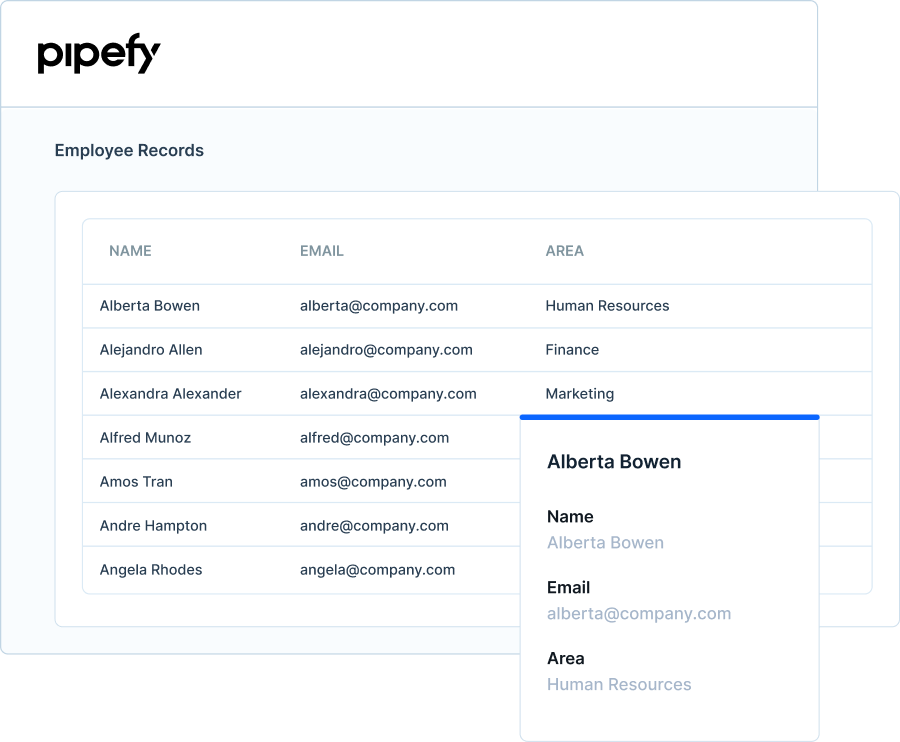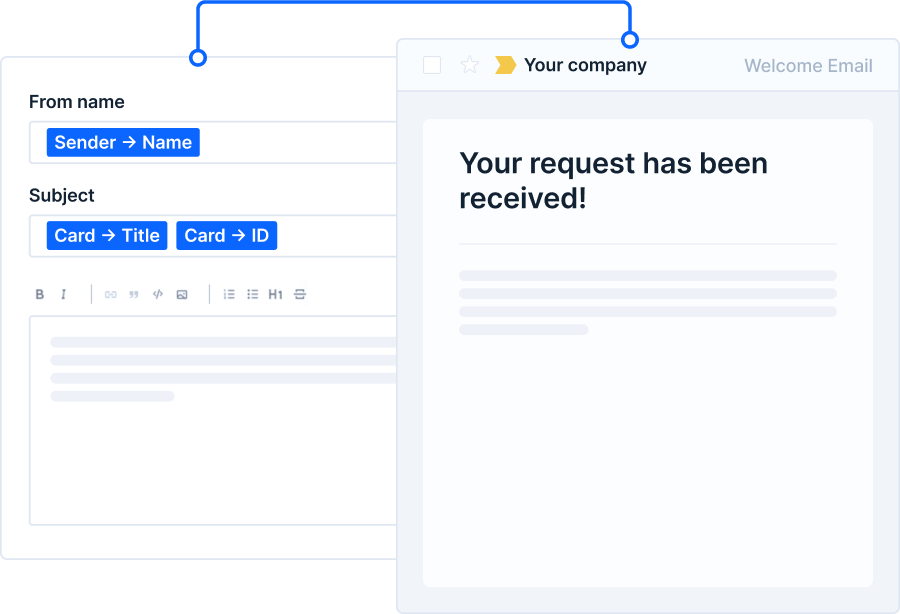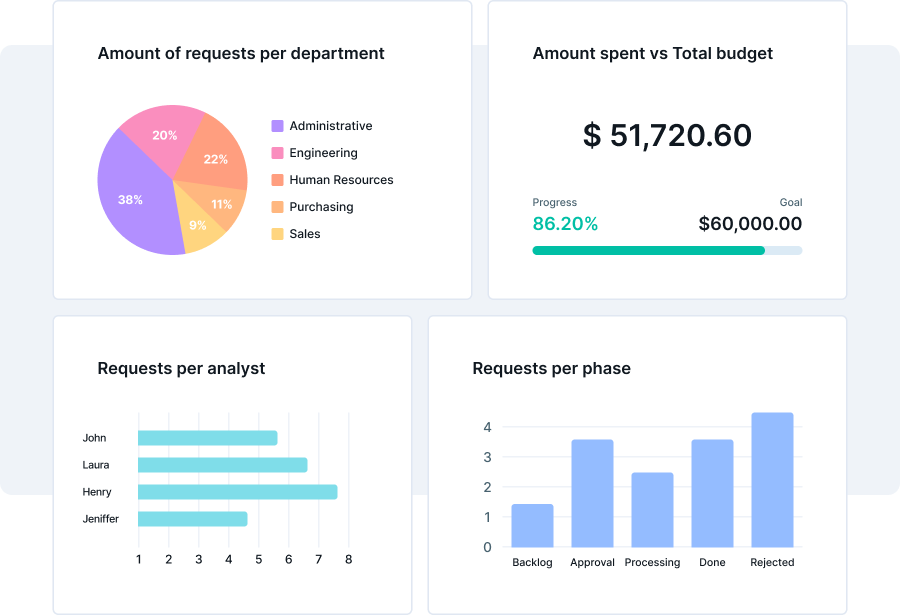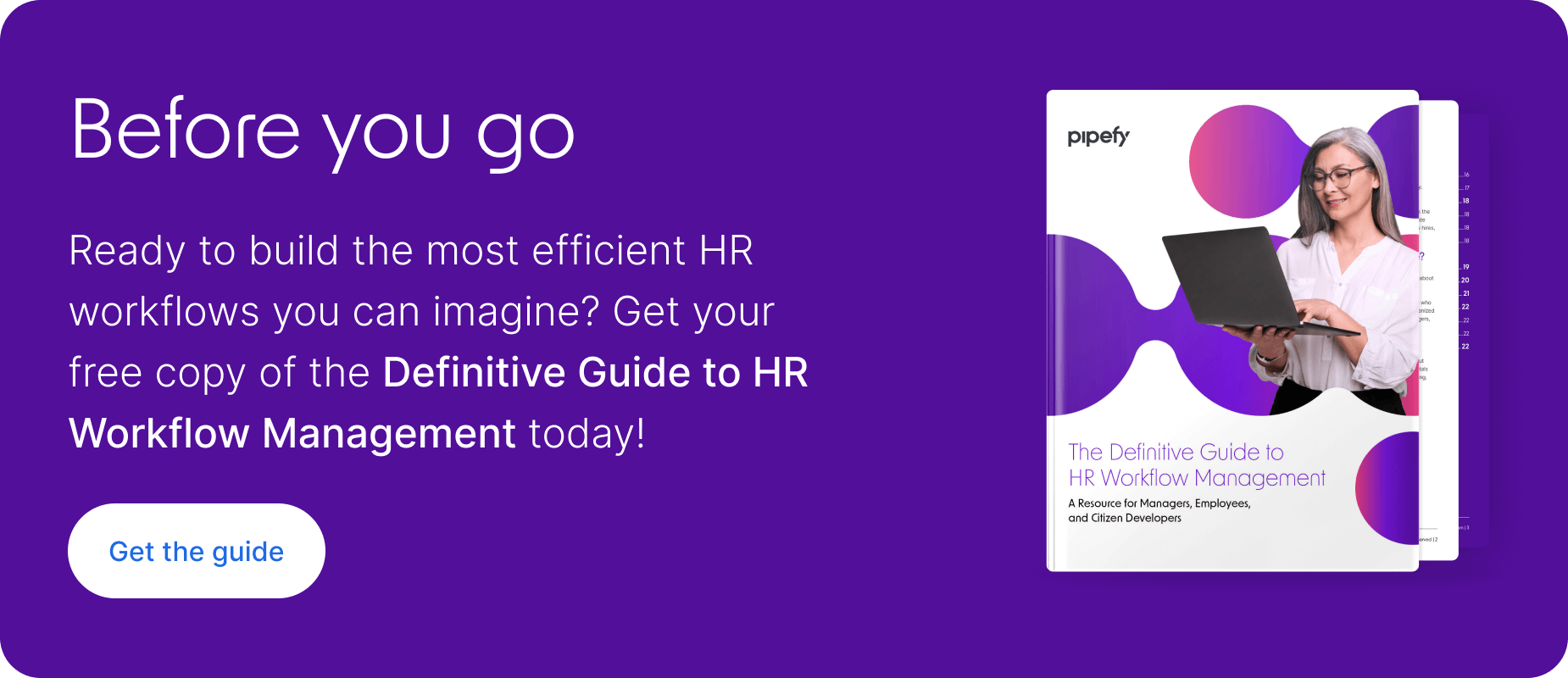
Human Resources teams know how important it is to manage different processes at the same time: from job openings, recruitment and onboarding, to general HR requests. Managing these recurring requests from your company’s internal customers is key to an HR department’s success.
It’s common for HR analysts and managers to often find themselves overwhelmed by the high volume of requests: such as vacation requests, salary adjustments, benefits questions, and more. Missing deadlines, having poor visibility, non-standardized requests, and repetitive work are common pain points HR teams face. In this article, we’re going to talk about how to manage a flawless HR requests process!
The end of HR headaches
When we talk about collaboration and agility, having a digitalized and automated process that gives HR the tools to effectively handle demands is integral. Keeping employee experiences positive is critical while addressing HR’s pains. Therefore, it is necessary to achieve a high level of efficiency in the following ways:
- Standardization. A single method of receiving requests, ensuring that all information arrives in a uniform, organized way without errors.
- Communication. Fast and easy communication with requesters, managers who make approvals, and other teams to always keep everyone on the same page.
- Visibility. Knowing the status, deadlines, and responsibilities for each request is crucial to unlocking an agile and traceable operation.
Once you have these three key points well established in your workflow, the entire process runs faster and smoother. With Pipefy, you can implement a process to manage different employee requests and achieve high performance.
How to build the ideal process to manage requests
In the Pipefy Template Gallery, you will find a template for HR requests that work as a starting point for further customization. This flowchart represents part of this basic template, with some phase additions:

Remember this is just the beginning and a simpler version of how a request workflow can be implemented inside Pipefy — it all depends on the needs and complexity of your process. Let’s check out all of its phases!
Stage 1: Receiving requests
HR requests pop up all over the place: in emails, phone calls, informal requests in a coffee break in the company, messages in Slack or Microsoft Teams… There are always employees with questions about health insurance, benefits, payments, and other matters — so it is necessary to have a single way to receive and centralize the demands.
In order not to be overloaded with a high volume of tasks, it is necessary to receive orders in a standardized way, which means they all must follow the same structure. Standardized data is without errors or the need for constant checks, saving time for analysts and managers when dealing with each request.
Forms: data turned into a request card in Pipefy
With Pipefy, you can create forms for HR requests. These forms are shared with an external link, without the employees having to log into any platform to submit their requests. Best of all, with forms you can customize each field with conditional rules, creating a dynamic experience.
For example, if someone selects that their request is about vacations, specific fields for vacation requests will appear. All forms (requests) are transformed into cards and show up in the first phase of the process in Pipefy, represented by a Kanban board in which cards move throughout the flow. Remember: you can customize forms and any phase of the process.
Portals: a channel with all HR forms gathered
To make organizing your forms easier, you can create an HR portal in Pipefy. A portal is a page that any employee can access freely, so it is possible to gather forms from different processes in a single place.
For example, if you want to have a specific form for vacation requests and another for general HR requests, you can create two workflows and separate them in the portal. Having a page with all the requests that your internal team can make, messages about how or where to open requests are minimized, and you receive everything in the same place.
Tracking: requesters aware of the status of each submission
Employees frequently ask HR about the status of their requests, providing follow-ups that could be avoided if they only had access to the order’s progress.
In Pipefy, after submitting the request form, employees receive a link by email where they can check which phase their requests are in and even communicate directly with the HR team. This way, it is not necessary to speak directly with the responsible analyst and, if necessary, the employee can get in touch via the link.
Stage 2: Backlog
Since all requests reach HR through the same way (Pipefy forms), it’s time to prioritize which requests should be answered and by whom. This is why it’s so crucial to have requisitions centralized, so it’s easy to check the volume and what types of demands are most urgent.
At this stage, HR analysts can filter requests, prioritize and give more or less urgency to the task according to what was written, check for missing information, and start the approval process, which normally involves members of other teams.
Automatic assignments
It is possible to create different types of automations in Pipefy to speed up the work of HR. For example, automations to assign a specific analyst for each type of demand (vacation requests, salary adjustments, etc.). Therefore, each person on the team can be in charge of a specific type of request and is automatically notified when it appears in the Backlog phase in Pipefy.
Employees database
With Pipefy’s databases feature, you can add an employee record to the database and create a library of the team staff with lots of pre-populated information. This way, it is easy to obtain data such as telephone, email, and address whenever new demands are opened.

Stage 3: Approval
In the Approval phase, we involve both external approvers (managers and leaders of other teams) and Human Resources analysts. Depending on the type of request, the phases the request will go through are different. For example, vacation requests need to be aligned with managers, while feedback and suggestions only go through HR.
It’s important to check all request data carefully so you don’t leave any information behind. It is possible to leave the request in the Waiting phase and contact other employees for further clarification, if necessary. If everything is ok, the request is approved. If there is any impediment, it is refused and a justification is detailed and sent to the employee.
Integration to speed up approval
To make communication easier, you can build integrations with multiple platforms like Slack and Microsoft Teams to trigger an automatic message to the approver. In Slack, it is even possible to carry out the approval on the platform itself (without having to access Pipefy), ensuring agility in the operation.
Automatic communication by emails
In Pipefy, it’s easy to automate sending emails according to your rules. With email templates, you can build a standard email template with dynamic fields, which are automatically updated with information from each request. This way, email communication is sped up and you no longer need to compose emails from scratch.
For example, sending emails with the employee’s name and status of their request can be done automatically, saving the HR team time.

Stage 4: Processing
This is the phase where HR analysts make the necessary records of the request. This activity itself can change a lot depending on the task, as we are dealing here with a general flow of requests, which may require updates in other systems, such as HRMS software. It is important to think about each scenario, as the process must adapt and meet the needs of all types of requests.
Integrations with the systems you want
As we mentioned, Pipefy can integrate with whatever systems you want, if you use other platforms to manage specific operations. In these cases, Pipefy works as the task center, sending information to other software and automatically updating the data across platforms.
For example, in the case of a request for compensation adjustments, the operation is carried out inside Pipefy along with other tasks, and integrations replicate the adjustments directly in BambooHR or other software of your choice.
Deadlines and labels so no information is forgotten
As important as having control of the requests that appear in the Backlog phase, it is important to have visibility of deadlines and urgencies. Pipefy allows you to add SLAs to each requisition card and generate automatic notifications when the deadline is approaching. Plus, labels help bring visibility to each request in Kanban — so you just have to take a look at the process to see what’s urgent.

Stage 5: Scheduling and completion
After approvals and processing requests, it is time to schedule (if necessary) and finish the request. For vacations, travel, and leave requests, for example, this is a mandatory phase of the process.
Again, it is up to HR to ensure that the stakeholders are properly notified and other systems are updated, so it is important to have employee information and history of everything in the process at your fingertips. Once everything is good to go, the request is effectively completed.
Integration with calendars and other tools
To facilitate communication with teams, you can create an integration with Google Calendar directly in Pipefy, and when you select dates, this will be directly reflected in the employee’s schedules.
Notifications by email
You can use email templates in the last phase of the process to trigger automated messages to employees with details of the completion of the request. In addition to communicating quickly and easily with the team, you ensure that everyone is notified without fail.
Keep an eye on HR request metrics
In any process, you need to track metrics to measure results and find opportunities for improvement. The purpose of having a digitized process for employee requests is precisely to streamline the operation while HR offers a better experience for the internal team. Therefore, it is necessary to keep an eye on metrics such as:
- Average wait time on the backlog
- Number of requests per HR analyst
- Average request resolution time
- Employee satisfaction level
- Most open types of requests
With valuable information on the team’s performance, it is easier to identify improvements and reduce service queues, redirecting analysts to each type of request. Data like this is essential for making strategic HR decisions, and you can extract it from Pipefy in different ways to meet your needs.
Reports and dashboards in Pipefy
Pipefy offers features for you to closely monitor request data. With pipe reports, you can extract process-specific data such as the number of requests per month, satisfaction level, average wait time, and more.
Dashboards allow you to visualize the data in different charts such as tables, bars, pie charts, and more. You don’t need any coding knowledge to edit charts or create custom reports. This guarantees autonomy in data analysis and speed in operation.

A digitized process at your fingertips
With an automated employee requests process, the HR team can achieve higher agility, decrease the wait time for each request, and create a positive experience for all employees. Here are the main benefits of implementing a request process in Pipefy:
- Centralization. All requests arrive at the same place and it is easy to consult history in a few clicks, with a complete view of the process.
- Standardization. An organized and well-structured process ensures a smooth flow and quick approvals, reducing follow-ups and constant verifications.
- Collaboration. Ease of communication between requesters and internal teams, ensuring visibility and quick access to information exchange.
- Optimization. Automations reduce time for repetitive and basic activities and increase team productivity, raising the bar of internal customer satisfaction.
- Data. Freedom to extract exactly the data you want, identify bottlenecks, and process improvement points with ease.
These are some of the advantages of having the employee requests process implemented in Pipefy. Remember that you can customize the workflow however you want, meeting your company’s specific needs and creating a robust process in just a few steps!










